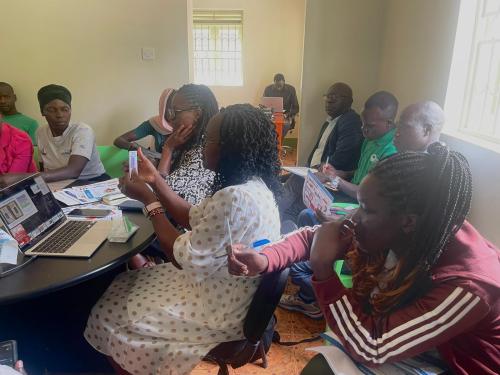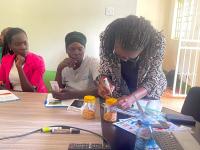
DryCard and dry chain workshop in Arua, Uganda
Taking dry chain training to Arua, Uganda
Arua City is located in Northwestern Uganda, and it is about 20 kilometers east of the border of the Democratic Republic of Congo and a few kilometers away from the South Sudan border. The city serves as a trade link for these three countries and hosts approximately 150,000 refugees.
The climate is suited for growing crops such as cassava (predominantly in season during our project visit) and corn, which are staple crops for the locals. In addition to these crops, mangoes, watermelons, eggplants, and pineapples do well in this region. According to the Arua investment profile, the district has vast fertile land, but less than 50% is under food production.
Farmers in Arua could benefit from value addition for many fruit and vegetable commodities. The project supported by Feed the Future Innovation Lab for Horticulture, “Developing innovative horticulture technologies for improved livelihoods for women small scale producers in Uganda,” has three objectives: to improve preharvest and postharvest practices; create market access linkages; and determine how farmer groups, cooperatives or shared aggregation centers can be enhanced. Led by Muni University, the research aims to transform the horticulture sector in this region by improving the nutrition, health, and income of small-scale farmers, including women.
While there is great potential to increase vegetable and fruit production in the Arua region, the Horticulture Innovation Lab’s project takes a systemic approach to value-chains. This includes providing small-scale farmers with information on postharvest management and innovations to reduce postharvest losses along with improving production practices. Rural smallholder farmers can generate great cassava, mango, and jackfruit harvests during peak seasons. During periods of glut during harvest peaks, effective storage and postharvest management can help increase farmer income and household access to nutritious horticulture crops. One method for long term preservation of crops is drying them.
Dry chain training

To help producers effectively preserve their dried products, the Horticulture Innovation Lab’s Lydiah Maranga conducted a dry chain, “train-the-trainer” workshop with seventeen attendees from different sectors including government, private sector, academia, and farmers. The dry chain is similar to the cold chain - drying products effectively, confirming they are safely dried, and safely storing them in water tight and air tight (hermetic) storage. The attendees of the training learned how to conduct a dry chain workshop to train others and how to use a set of low-cost innovations to implement the dry chain. These innovations are accessible to users in Uganda and include the DryCard, low-cost solar dryers, along with hermetic storage.

There was a lot of interest in learning about the various components that make up a dry chain. Engaged participants gained greater understanding of how aflatoxin contamination can occur during improper postharvest management, how to determine dryness with the DryCard, and the benefits of various drying approaches. Innovations discussed, along with the DryCard, included UC Davis’ chimney solar dryer, pallet dryer, and the PICS hermetic storage bag. Dr. Robert Kajobe, the Project PI plans to construct the chimney solar dryer in collaboration with a local private company, Omia Agribusiness, as a demonstration resource for farmers.
The Horticulture Innovation Lab works with various stakeholders in the value chain to understand the existing practices and identify knowledge gaps to provide additional research findings that could be vital in complementing local knowledge. Effectively implementation of the dry chain for horticulture crops has the potential to reduce food loss and waste by creating value-add products that are nutritious and can be sold or consumed.
